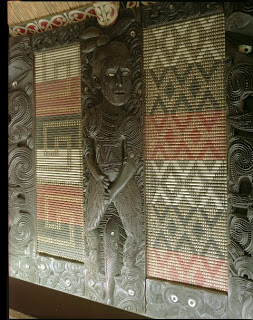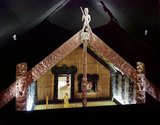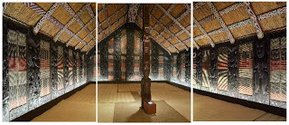John Hurrell – 31 May, 2009
Because Adams uses a large-format 8 x 10 inch field camera it is wonderful to see untrimmed prints pinned to the gallery wall that really provide a sense of the architecture around Waitere's carvings. Glossy with remarkable acuity, the tonal range of the C-prints is more pronounced than the same images on the published page. They have far greater depth, and often wide images are made by positioning three large coloured photographs side by side.
Auckland
Mark Adams
Rauru
Book launch. Rauru: Tene Waitere, Maori Carving, Colonial History, ed. Nicholas Thomas
21 May - 27 June 2009
This is an exhibition of a selection of photographs Mark Adams took for a book recently launched at Two Rooms and published by Otago University Press. The hardcover publication examines the life and work of a remarkable Māori carver, Tene Waitere ( Ngati Tarawhai) 1854 -1931 who worked in the Te Arawa tradition and who lived at Ruato on Lake Rotoiti. Adams provides the visual documentation of Waitere’s labours, purchased by European and Māori alike, and found now not only in Aotearoa but also England and Germany. The book contains about a hundred of Adams’ images, some taken in the mid-eighties.
This publication, edited by essay contributor Nicholas Thomas (Professor of Anthropology at Cambridge) with interviews with Waitere’s great-grandson James Schuster and Lyonel Grant, a contemporary Māori carver, will be revelatory to many people like myself who have never heard of Waitere and his achievements.
Because Adams uses a large-format 8 x 10 inch field camera it is wonderful to see untrimmed prints pinned to the gallery wall that really provide a sense of the architecture around Waitere’s carvings. Glossy with remarkable acuity, the tonal range of the C-prints is more pronounced than the same images on the published page. They have far greater depth, and often wide images are made by positioning three large coloured photographs side by side.
The highlights are several images of interiors within two extraordinary buildings. One of those is Te Tiki-a-Tamamutu, The Spa Hotel, Taupo, where the some of the figures have unusually angular, zigzagging facial motifs. The other is Rauru, a house sold by the Rotorua Hotel Manager C.E.Nelson in 1904 to the Museum Fur Volkerkunde Hamburg.
In Rauru the images of the mythical God/hero Māui in particular are sensational. In one he is hauling the North Island (shown as a fish) out of the sea. In another he is attempting to enter the sleeping body of the Goddess of the Underworld (Hine-nui-te-pō) through her vulva with the intention of murdering her, but she is awoken by a laughing fantail and crushes him first.
Waitere brings these wonderful stories to life, as does Adams in his documentation, for in Hamburg the dark painted wooden columns are lit from behind skirting boards near the floor. The upper heads, eyes and torsos glow in ominous intensity, while the legs, feet and lower panels are strangely bleached by the upward directed light.
While the book is bound to be acquired by many libraries, Adams’ meticulous images, experienced directly, are very special. Don’t miss them.
John Hurrell



 Advertising in this column
Advertising in this column Two Rooms presents a program of residencies and projects
Two Rooms presents a program of residencies and projects



This Discussion has 0 comments.
Comment
Participate
Register to Participate.
Sign in
Sign in to an existing account.